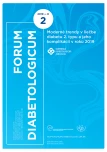Current diagnostic and therapeutic possibilities of diabetic retinopathy and macular edema
Authors:
Mária Molnárová
Authors‘ workplace:
VIKOM, s. r. o., 1. žilinské očné centrum, Žilina
1; Očná klinika JLF UK, Martin
2
Published in:
Forum Diab 2019; 8(2): 106-110
Category:
Review Article
Overview
In the upcoming decade a rapid increase in DM and thereby also diabetic retinopathy is envisaged. The improvement of diagnostic and therapeutic possibilities significantly enhances and accelerates the clinical and socio-economic effectiveness of therapeutic procedures. In the treatment of PDR still predominates laser coagulation. In the treatment of diabetic macular edema, laser therapy was replaced by intravitreal pharmacotherapy with anti-growth factors. Steroids administered intravitreally remain reserved for chronic macular edema. Surgical treatment – pars plana vitrectomy – is indicated for advanced proliferative diabetic retinopathy and chronic persistent diabetic macular edema not responding to intravitreal antiVEGF or steroid therapy.
Keywords:
surgery – A OCT – antiVEGF – diabetic macula edema – Diabetic retinopathy – FAG – OCT – surgical treatment
Sources
- Davis MD, Fisher MR, Gangnon RE. Risk factors for high-risk proliferative diabetic retinopathy and severe visual loss: Early Treatment Diabetic Retinopathy Study Report #18. Invest Ophthalmol Vis Sci 1998; 39(2): 233–252.
- Progression of retinopathy with intensive versus conventional treatment in the Diabetes Control and Complications Trial. Diabetes Control and Complications Trial Research Group. Ophthalmology 1995; 102(4): 647–661.
- Intensive blood-glucose control with sulphonylureas or insulin compared with conventional treatment and risk of complications in patients with type 2 diabetes (UKP - DS 33). UK Prospective Diabetes Study (UKPDS) Group. Lancet 1998; 352(9131): 837–853.
- Keech AC, Mitchell P, Summanen PA et al. Effect of fenofibrate on the need for laser treatment for diabetic retinopathy (FIELD study): a randomised controlled trial. Lancet 2007; 370(9600): 1687–1697.
- Schmidt-Erfurth U, Garcia-Arumi J, Bandello F et al. Guidelines for the Management of Diabetic Macular Edema by the European Society of Retina Specialists (EURETINA). Ophthalmologica 2017; 237(4): 185–222. Dostupné z DOI: <http://doi: 10,1159/000458539>.
- Bresnick GH. Diabetic macular edema. A review. Ophthalmology 1986; 93(7): 989–997.
- Early Treatment Diabetic Retinopathy Study Research Group. Treatment techniques and clinical guidelines for photocoagulation of diabetic macular edema. Early Treatment Diabetic Retinopathy Study Report Number 2. Ophthalmology 1987; 94(7): 761–774.
- Wang H, Chhablani J, Freeman WR et al. Characterization of diabetic microaneurysms by simultaneous fluorescein angiography and spectraldomain optical coherence tomography. Am J Ophthalmol 2012; 153(5): 861–867. Dostupné z DOI: <http://doi: 10.1016/j.ajo.2011.10.005>.
- Schmidt-Erfurth U, Chong V, Loewenstein A et al. Guidelines for the management of neovascular age-related macular degeneration by the European Society of Retina Specialists (EURETINA). Br J Ophthalmol 2014; 98(9): 1144–1167. Dostupné z DOI: <http://doi: 10.1136/bjophthalmol-2014–305702>.
- Hwang TS, Gao SS, Liu L et al. Automated Quantification of Capillary Nonperfusion Using Optical Coherence Tomography Angiography in Diabetic Retinopathy. JAMA Ophthalmol 2016; 134(4): 367–373. Dostupné z DOI: <http://doi: 10.1001/jamaophthalmol.2015.5658>.
- Couturier A, Mane V, Bonnin S et al. Capillary plexus anomalies in diabetic retinopathy on optical coherence tomography angiography. Retina 2015; 35(11): 2384–2391. Dostupné z DOI: <http://doi: 10.1097/IAE.0000000000000859>.
- [The Diabetic Retinopathy Study research Group]. Photocoagulation treatment of proliferative diabetic retinopathy. Clinical application of Diabetic Retinopathy Study (DRS) findings, DRS Report Number 8. Opohthalmology 1981; 88(7): 583–600.
- Mitchell P, Bandello F, Schmidt-Erfurth U et al. The RESTORE study: ranibizumab monotherapy or combined with laser versus laser monotherapy for diabetic macular edema. Ophthalmology 2011; 118(4): 615–625. Dostupné z DOI: <http://doi: 10.1016/j.ophtha.2011.01.031>.
- Lavinsky D, Cardillo JA, Melo LA jr et al. Randomized clinical trial evaluating mETDRS versus normal or high-density micropulse photocoagulation for diabetic macular edema. Invest Ophthalmol Vis Sci 2011; 52(7): 4314–4323. Dostupné z DOI: <http://doi: 10.1167/iovs.10–6828>.
- Nguyen QD, Brown DM, Marcus DM et al. Ranibizumab for diabetic macular edema: results from 2 phase III randomized trials: RISE and RIDE. Ophthalmology 2012; 119(4): 789–801. Dostupné z DOI: <http://doi: 10.1016/j.ophtha.2011.12.039>.
- Korobelnik JF, Do DV, Schmidt-Erfurth U et al. Intravitreal aflibercept for diabetic macular edema. Ophthalmology 2014; 121(11): 2247–2254. Dostupné z DOI: <http://doi: 10.1016/j.ophtha.2014.05.006>.
- Wells JA, Glassman AR, Ayala AR et al. Aflibercept, bevacizumab, or ranibizumab for diabetic macular edema. N Engl J Med 2015; 372(13): 1193–1203. Dostupné z DOI: <http://doi: 10.1056/NEJMoa1414264>.
- Prunte C, Fajnkuchen F, Mahmood S et al. Ranibizumab 0.5 mg treat-and-extend regimen for diabetic macular oedema: the RETAIN study. Br J Ophthalmol 2016; 100(6): 787–795. Dostupné z DOI: <http://doi: 10.1136/bjophthalmol-2015–307249>.
- Wells JA, Glassman AR, Ayala AR et al. Aflibercept, Bevacizumab, or Ranibizumab for Diabetic Macular Edema: Two-Year Results from a Comparative Effectiveness Randomized Clinical Trial. Ophthalmology 2016; 123(6): 1351–1359. Dostupné z DOI: <http://doi: 10.1016/j.ophtha.2016.02.022>.
- Zhang X, Zeng H, Bao S t al. Diabetic macular edema: new concepts in patho-physiology and treatment. Cell Biosci 2014; 4 : 27. Dostupné z DOI: <http://doi: 10.1186/2045–3701–4–27>.
- Boyer DS, Yoon YH, Belfort R jr et al. Three-year, randomized, sham-controlled trial of dexamethasone intravitreal implant in patients with diabetic macular edema. Ophthalmology 2014; 121(10): 1904–1914. Dostupné z DOI: <http://doi: 10.1016/j.ophtha.2014.04.024>.
- Cunha-Vaz J, Ashton P, Iezzi R et al. Sustained delivery fluocinolone acetonide vitreous implants: long-term benefit in patients with chronic diabetic macular edema. Ophthalmology 2014; 121(10): 1892–1903. Dostupné z DOI: <http://doi: 10.1016/j.ophtha.2014.04.019>.
- Bhagat N, Grigorian RA, Tutela A et al. Diabetic macular edema: pathogenesis and treatment. Surv Ophthalmol 2009; 54(1): 1–32. Dostupné z DOI: <http://doi: 10.1016/j.survophthal.2008.10.001>.
- Haller JA, Qin H, Apte RS et al. Vitrectomy outcomes in eyes with diabetic macular edema and vit - reomacular traction. Ophthalmology 2010; 117(6): 1087–1093. e1083. Dostupné z DOI: <http://doi: 10.1016/j.ophtha.2009.10.040>.
- Kanski JJ. Clinical Ophthalmology. 8rd ed. Saunders 2015. ISBN-13 : 978–0702055720. ISBN-10 : 0702055727.
Labels
Diabetology Endocrinology Internal medicineArticle was published in
Forum Diabetologicum

2019 Issue 2
Most read in this issue
- Modern trends in the treatment of hypertension
- Updates in obesity pharmacotherapy
- Modern trends in local treatment of diabetic foot
- Insulin pump treatment in type 1 diabetes mellitus – for whom and why?
